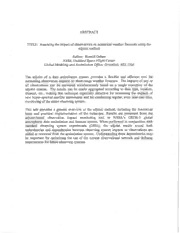
NASA Technical Reports Server (NTRS) 20120015937: Assessing the Impact of Observations on Numerical Weather Forecasts Using the Adjoint Method PDF
Preview NASA Technical Reports Server (NTRS) 20120015937: Assessing the Impact of Observations on Numerical Weather Forecasts Using the Adjoint Method
ABSTRACT TITLE: Assessing the impact of observations on numerical weather forecasts using the adj oint method Author: Ronald Gelaro NASA, Goddard Space Flight Center Global Modeling and Assimilation Office, Greenbelt, MD, USA The adjoint of a data assimilation system provides a flexible and efficient tool for estimating observation impacts on short-range weather forecasts. The impacts of any or all observations can be estimated simultaneously based on a single execution of the adjoint system. The results can be easily aggregated according to data type, location, channel, etc., making this technique especially attractive for examining the impacts of new hyper-spectral satellite instruments and for conducting regular, even near-real time, monitoring of the entire observing system. This talk provides a general overview of the adjoint method, including the theoretical basis and practical implementation of the technique. Results are presented from the adjoint-based observation impact monitoring tool in NASA's GEOS-5 global atmospheric data assimilation and forecast system. When performed in conjunction with standard observing system experiments (OSEs), the adjoint results reveal both redundancies and dependencies between observing system impacts as observations are added or removed from the assimilation system. Understanding these dependencies may be important for optimizing the use of the current observational network and defining requirements for future observing systems.
